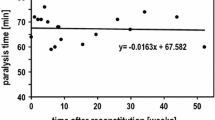Abstract
Botulinum toxin (BT) is provided by several manufacturers producing a number of different drugs. Their potency is given in internationally standardised mouse units (MU). Clinical practise, however, reveals that the potency labelling of different BT drugs may not be identical. We wanted to use the mouse diaphragm assay (MDA) to compare the two BT drugs onabotulinumtoxinA (ONA) and incobotulinumtoxinA (INCO). For this, we measured the paresis time (PT) of different ONA or INCO doses. All BT came from several different and unexpired drug batches. PT for 20MU were 169.7 ± 28.9 min (ONA) and 132.3 ± 1.5 min (INCO) (p = 0.089), for 60MU 105.3 ± 10.1 min and 84.7 ± 4.2 min (p = 0.031), for 100MU 69.7 ± 1.5 min and 66.0 ± 7.0 min (p = 0.462) and for 140MU 74.7 ± 0.6 min and 62.3 ± 2.1 min (p = 0.100), respectively. The overall PT were 104.8 ± 12.5 and 86.3 ± 8.5 min (p = 0.178). Results presented here do not reveal differences in potency labelling between ONA and INCO, even when the full range of therapeutic doses are examined, although there was a trend towards stronger INCO effects. Data confirm previous reports on identical potency labelling of ONA and INCO. The MDA seems to be an appropriate instrument to test the potency labelling of other BT drugs as well, including new BT drugs currently under development.

Similar content being viewed by others
References
Benecke R, Jost WH, Kanovsky P, Ruzicka E, Comes G, Grafe S (2005) A new botulinum toxin type A free of complexing proteins for treatment of cervical dystonia. Neurology 64:1949–1951
Brin MF, Blitzer A (1993) Botulinum toxin: dangerous terminology errors. J R Soc Med 86:493–494
Buelbring E (1946) Observation on the isolated phrenic nerve diaphragm preparation in the rat. Br J Pharmacol 1:38–61
Dressler D (2009) Routine use of Xeomin® in patients pre-treated with Botox®. Eur J Neurol 16(Suppl 2):2–5
Dressler D (2010) Comparing Botox® and Xeomin® for the treatment of axillar hyperhidrosis. J Neural Transm 117:317–319
Dressler D (2012) Five-year experience with incobotulinumtoxinA (Xeomin®): the first botulinum toxin drug free of complexing proteins. Eur J Neurol 19:385–389
Dressler D, Bigalke H (2016) Comparing incobotulinumtoxina (Xeomin) and onabotulinumtoxina (Botox): identical potency labeling in the hemidiaphragm assay. Toxicon 123:S23
Dressler D, Mander G, Fink K (2012) Measuring the potency labelling of onabotulinumtoxinA (Botox®) and Xeomin® in an LD50 assay. J Neural Transm 119:13–15
Dressler D, Tacik P, Adib Saberi F (2014) Botulinum toxin therapy of cervical dystonia: comparing Botox® and Xeomin®. J Neural Transm 121:29–31
European Pharmacopoeia 6.0 (2008a) Botulinum toxin type A for injection 1327–1329
European Pharmacopoeia 6.0 (2008b) Statistical analysis of biological assays and tests. 5.3: 571–600
Goeschel H, Wohlfahrt K, Frevert J, Dengler R, Bigalke H (1997) Botulinum A toxin: neutralizing and nonneutralizing antibodies—therapeutic consequences. Exp Neurol 147:96–102
Hunt T, Clarke K (2009) Potency evaluation of a formulated drug product containing 150-kd botulinum neurotoxin type A. Clin Neuropharmacol 32:28–31
Kranz G, Haubenberger D, Voller B, Posch M, Schnider P, Auff E, Sycha T (2009) Respective potencies of Botox and Dysport in a human skin model: a randomized, double-blind study. Mov Disord 24:231–236
Marion MH, Sheehy M, Sangla S, Soulayrol S (1995) Dose standardisation of botulinum toxin. J Neurol Neurosurg Psychiat 59:102–103
Marsden CD (1993) Botulinum toxin: dangerous terminology errors. J R Soc Med 86:494
Pearce LB, Borodic GE, First ER, MacCallum RD (1994) Measurement of botulinum toxin activity: evaluation of the lethality assay. Toxicol Appl Pharmacol 128:69–77
Ranoux D, Gury C, Fondarai J, Mas JL, Zuber M (2002) Respective potencies of Botox and Dysport: a double blind, randomised, crossover study in cervical dystonia. J Neurol Neurosurg Psychiatry 72:459–462
Roggenkämper P, Jost WH, Bihari K, Comes G, Grafe S, For the NT 201 Blepharospasm Study Team (2006) Efficacy and safety of a new Botulinum Toxin Type A free of complexing proteins in the treatment of blepharospasm. J Neural Transm 113:303–312
Scaglione F (2016) Conversion ratio between Botox®, Dysport®, and Xeomin® in clinical practice. Toxins 8:65. https://doi.org/10.3390/toxins8030065
Van den Bergh P, Lison D, Dose standardisation of BTX (1996) 3rd International Dystonia Symposium, October 9–11, 1996, Miami, Florida. Affiliated National Dystonia Associations, Chicago, Illinois, p 30
Wohlfarth K, Schwandt I, Wegner F, Jürgens T, Gelbrich G, Wagner A, Bogdahn U, Schulte-Mattler W (2009) Biological activity of two botulinum toxin type A complexes (Dysport® and Botox®) in volunteers. A double-blind, randomized, dose-ranging study. J Neurol 256:1201–1201
Author information
Authors and Affiliations
Corresponding author
Ethics declarations
Conflict of interest
DD received honoraria for consultations from Allergan, Ipsen, IAB-Interdisciplinary Working Group for Movement Disorders, Merz and Syntaxin. He is a shareholder of Allergan. He holds patents in botulinum toxin research. LP has nothing to disclose. HB is founder and co-owner of Toxogen.
Rights and permissions
About this article
Cite this article
Dressler, D., Pan, L. & Bigalke, H. Comparing incobotulinumtoxinA (Xeomin®) and onabotulinumtoxinA (Botox®): identical potency labelling in the hemidiaphragm assay. J Neural Transm 125, 1351–1354 (2018). https://doi.org/10.1007/s00702-018-1897-x
Received:
Accepted:
Published:
Issue Date:
DOI: https://doi.org/10.1007/s00702-018-1897-x




